Introduction
While the appearance of hairlessness is the first remarkable impression of the Sphynx, among enthusiasts of the breed it is most recognized for it’s overtly affectionate disposition. The breed is often described as being part monkey, part dog and part baby. This illustrates a beautiful picture of what one can expect when sharing their life with a Sphynx. This is a very needy and dependent cat, which requires enormous amounts of interaction and affection. Ask any Sphynx breeder or owner about their devotion to the breed and you will find a commitment, love and enthusiasm towards them like no other.
The Sphynx is not truly hairless. The skin should have the texture of chamois. It may be covered with very fine down which is almost imperceptible to both the eye and the touch. On the ears, muzzle, tail, feet and scrotum, short, soft, fine hair is allowed. Lack of coat makes the cat quite warm to the touch. Whiskers and eyebrows may be present, broken, or may be totally absent. The cat should not be small or dainty. Males may be up to 25 percent larger so long as proper proportions are maintained. The Sphynx is sweet-tempered, lively, intelligent and above all amenable to handling.

Head general
Arguably one of the breed’s most eye-catching features, perhaps second only to their appearance of hairlessness. You may have noticed two varying head types within the breed; a slightly shorter modified wedge shaped head and a slightly longer modified wedge shaped head. Both fit within the breed standard verbiage, which is deliberately subjective to allow for “cattery looks” which come about from outcross programs working with different permissible outcrosses within the breed. While slight variations can still fit well within the Standard’s description of “slightly longer then wide”, a head type that brings to mind a Devon Rex or Exotic Shorthair is not correct. Conversely, a head type that brings to mind a Cornish Rex or Donskoy is also not correct.
Head size and shape
Medium-sized
Modified wedge with rounded contours
Slightly longer than wide
Skull is slightly rounded with a rather flat forehead
Prominent cheekbones
Distinct whisker break
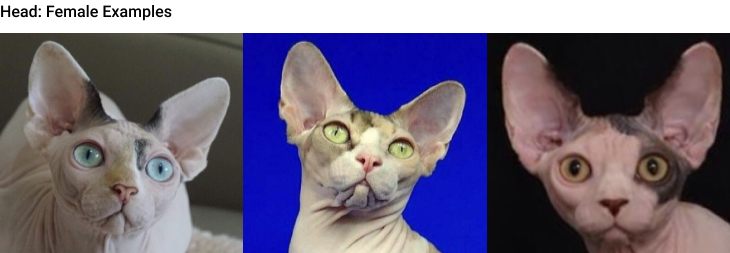

Head: Cheekbones
Prominent, well rounded cheekbones that define the eye and form a curve just above the whisker break
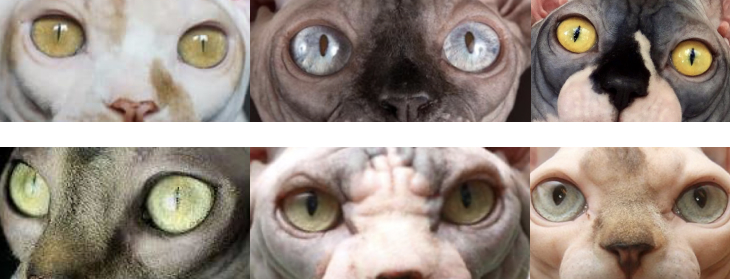
Head: Muzzle and Chin
Strong rounded muzzle with distinct whisker break and firm chin
The muzzle should give the appearance of ”kissing a window”. It should be strong and well padded, rounded and with a distinct whisker break, supported by a firm, well developed chin.
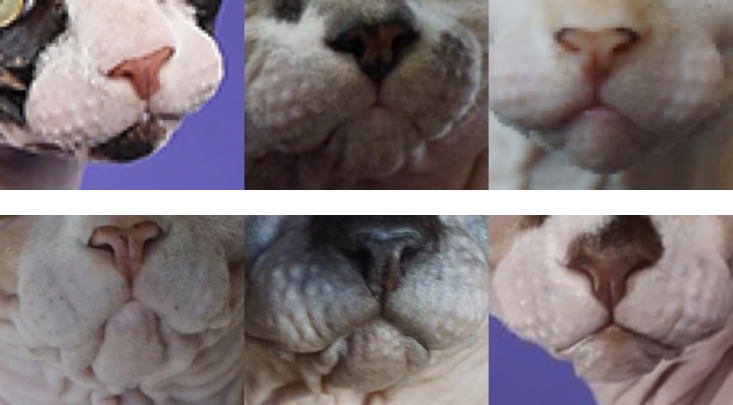
Head: ears
- Very large, broad at base and open
- Set upright, neither low set nor on top of the head
- The interior is totally hairless
- Slight amount of hair allowed on the lower outside edges and on the back of the ear

Head: Profile
Slight to moderate change or direction at bridge of nose, slight degree of fuzz on bridge of nose.
When viewed from the side, the bridge of the nose is straight with a slight to moderate change of direction in the profile leading up into the flat plane of the forehead. The chin is firm and lines up vertically with the end of the muzzle. It is important to note that some Sphynx have more fuzz on the bridge of their noses, which can either give the erroneous impression of a strong profile, or conversely the erroneous impression of a straight profile. As such, it is important to feel the stop manually.
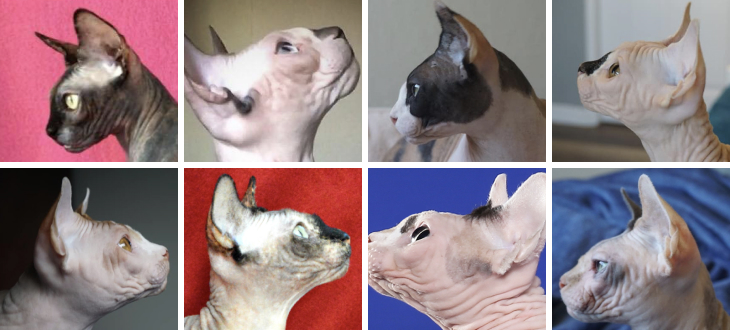
Head: eyes
- Large, rounded lemon shape
- Slanting to outer corner of the ear
- Slightly more than an eye width between the eyes

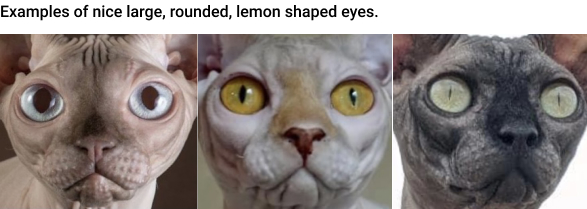
Head: neck
- Medium in length, rounded and well muscled
- The neck arches from the shoulders to the base of the skull and is powerful, especially in males
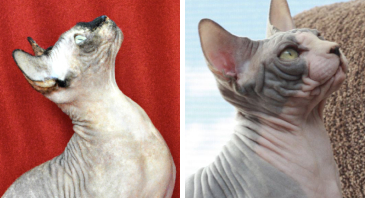
Body: general
- Medium sized, medium to medium long in length
- Broad chest, may tend towards barrel chested with front legs widely set
- Well rounded abdomen, having the appearance of having eaten a large meal, but not fat
- Leg length proportionate to body, medium boned and firm musculature
- Hind legs slightly longer than front
- Feet are medium in size, oval shaped and with long slender toes
- Pawpads are thicker than in other breeds, giving the appearance of walking on “air cushions”
- The tail is whippy, rat-like and tapering from body to tip
- Should not be delicate, refine in boning, or over all small
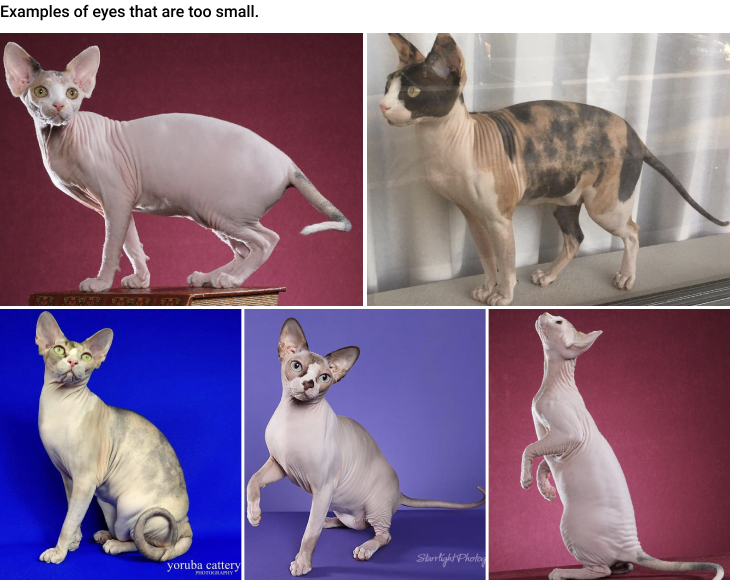
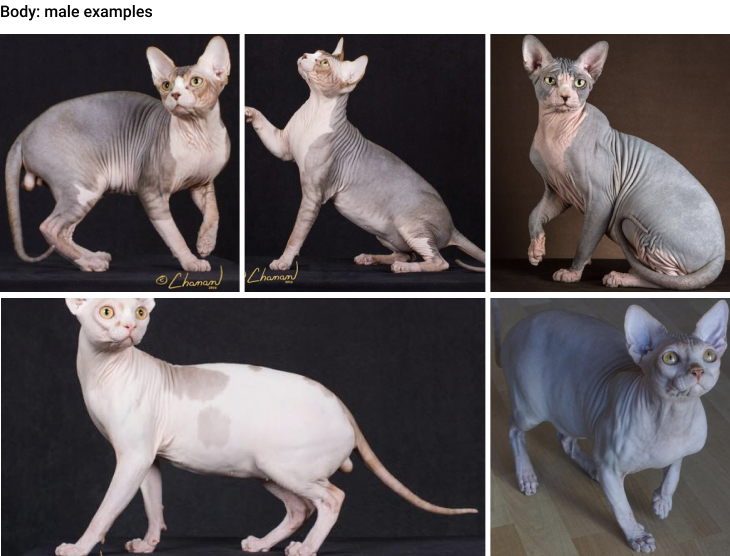
Body: legs and feet
- Length in proportion with body
- Medium boning, though females may have slightly finer boning
- Hind legs slightly longer then front
- Front legs are widely set to accommodate a broad chest
- Feet are medium sized and oval in shape
- Toes are very long, slender and prominent
- Uniquely thick pawpads, giving the appearance of walking on “air cushions”
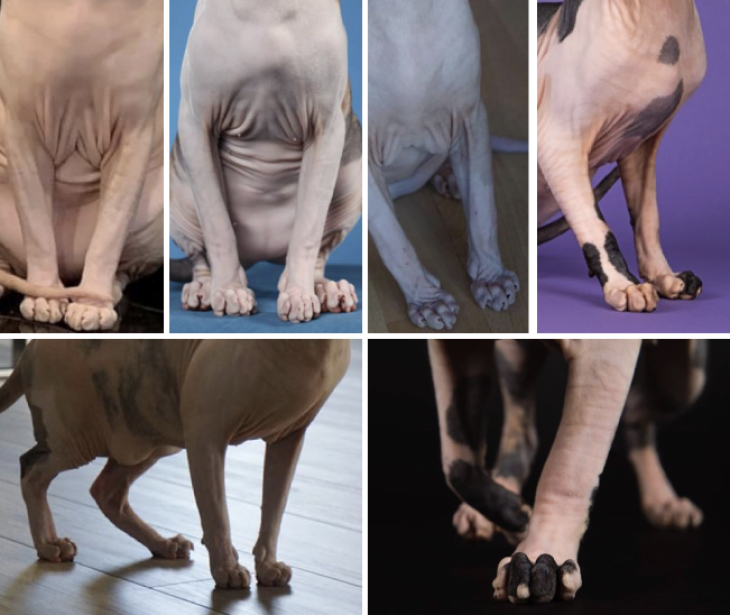
Body: tail
- Whippy, tapering from body to tip (rat tailed)
- Length is in proportion to body
- Short, soft, fine hair is allowed on the tail, as is a ”lion tail” (puff of hair on tip)

Сoat
- Appears hairless, but may be covered with short, fine down
- The texture is chamois-like, or the feeling of soft suede
- The skin is very wrinkled in kittens
- Adults should retain as many wrinkles as possible, especially on the head
- Wrinkling should not be so pronounced that it affects the cat’s normal function
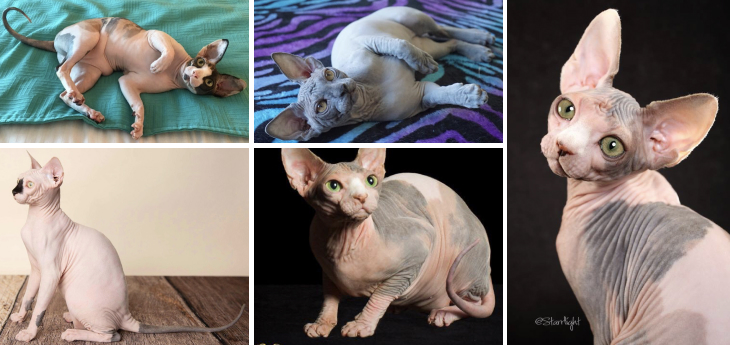
Сolor
- All colors of all divisions are accepted
- Allowance made for lockets
- Here is a little tip in determining what color a Sphynx is:
The coated parts on the sphynx, like the back of the ears,
bridge of the nose and sometimes the paws, will give you
the most accurate gauge of pigmentation.
Penalize, withhold awards and disqualify
- Penalize: Overall small cat. Body that is too thin, frail-appearing or delicate or fine-boned; too cobby or foreign. Lack of wrinkles on the head. Straight profile, narrow head. Non-amenable disposition. Significant amounts of hair above the ankle.
- Withhold all Awards: Any indication of wavy hair or suggestion of the Devon Rex, or Cornish Rex in molt.
- Disqualify: Any evidence of depilitating, plucking, shaving, clipping or any other means of hair removal. Inability to handle.
